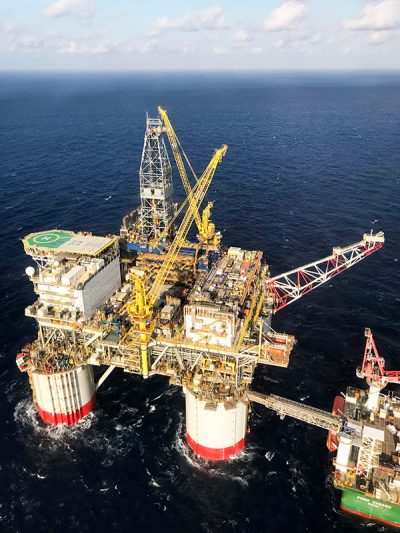
12/11/2018
NEW ORLEANS, LA -
The Bureau of Safety and Environmental Enforcement recently conducted its final pre-production inspection of Chevron’s Big Foot tension leg platform, moored in the Gulf of Mexico about 225 miles south of New Orleans. BSEE deemed it safe for operation on Nov. 15, 2018, and five days later it saw first oil.
“The mission of the Bureau of Safety and Environmental Enforcement is to ensure offshore oil and gas companies operate in a safe and environmentally sustainable way,” said Amy Pellegrin, BSEE’s Houma District acting district manager. “Big Foot is the second deepwater production facility to come on line in our district this year and we’ve been monitoring their activities to ensure they meet all federal regulations.”
From the time an oil company decides to pursue a project until it actually begins producing usually takes about 10 years. In Big Foot’s case, that time was extended by a few years because of technical difficulties involving the 16 mooring tendons during the initial installation in 2015. Those issues had to be resolved before the platform could be attached and operated safely.
After the mooring complication, BSEE continued to monitor Chevron's plans to secure and stabilize the mooring lines.
Big Foot’s mooring tendons needed to better withstand a strong loop current, which is an ocean current that transports warm Caribbean water through the Yucatan Channel between Cuba and Mexico and up through the Gulf of Mexico.
“New technologies and innovation are brought into each new platform design,” said Devon Hillman, BSEE Gulf of Mexico petroleum engineer. “As operators take on more deepwater exploration and production, they adapt to the many challenges deepwater brings.”
BSEE’s role is to ensure those adaptations are safe and environmentally sustainable.
BSEE conducted several production safety system reviews and pre-production inspections prior to approving Chevron’s move to begin production on Big Foot.
“With each physical inspection, we confirmed that Chevron’s schematics, diagrams and plans were accurate and that the systems would operate as designed,” Pellegrin said.
The Big Foot platform is located in the Walker Ridge 29 area of the Gulf of Mexico in about 5,200 feet of water and it has a capacity of 75,000 barrels of oil and 25 million cubic feet of gas per day.
The Houma District is one of five district offices in BSEE’s Gulf of Mexico Region and regulates multiple shallow and deepwater oil and gas platforms, drilling rigs and subsea pipelines.
====================================
Chevron announces first oil from Big Foot Project in the deepwater Gulf of Mexico; deepest tension leg platform
26 November 2018
Chevron Corporation announced that the Chevron-operated Big Foot deepwater project, located in the US Gulf of Mexico, has started crude oil and natural gas production. The field is located approximately 225 miles (360 km) south of New Orleans, La., in a water depth of approximately 5,200 feet (1,584 m).
The Chevron-operated Big Foot project (co-owners are Statoil and Marubeni) uses a 15-slot drilling and production tension-leg platform—the deepest of its kind in the world—and is designed for a capacity of 75,000 barrels of oil and 25 million cubic feet of natural gas per day.
A tension-leg platform (TLP) is a buoyant platform held in place by a mooring system. The buoyancy of the hull offsets the weight of the platform, requiring clusters of tight tendons, or tension legs, to secure the structure to a foundation on the seabed, which is kept stationary by piles driven into the seabed.
The mooring system allows for horizontal movement with wave disturbances, but does not permit vertical (bobbing) movement.
Chevron selected the ETLP, FloaTEC’s proprietary design, as the optimum floating production system for this field development. FloaTEC was contracted to provide detailed design of the hull and mooring system.
The Big Foot field was discovered in 2006, is estimated to contain total recoverable resources of more than 200 million oil-equivalent barrels and has a projected production life of 35 years.


